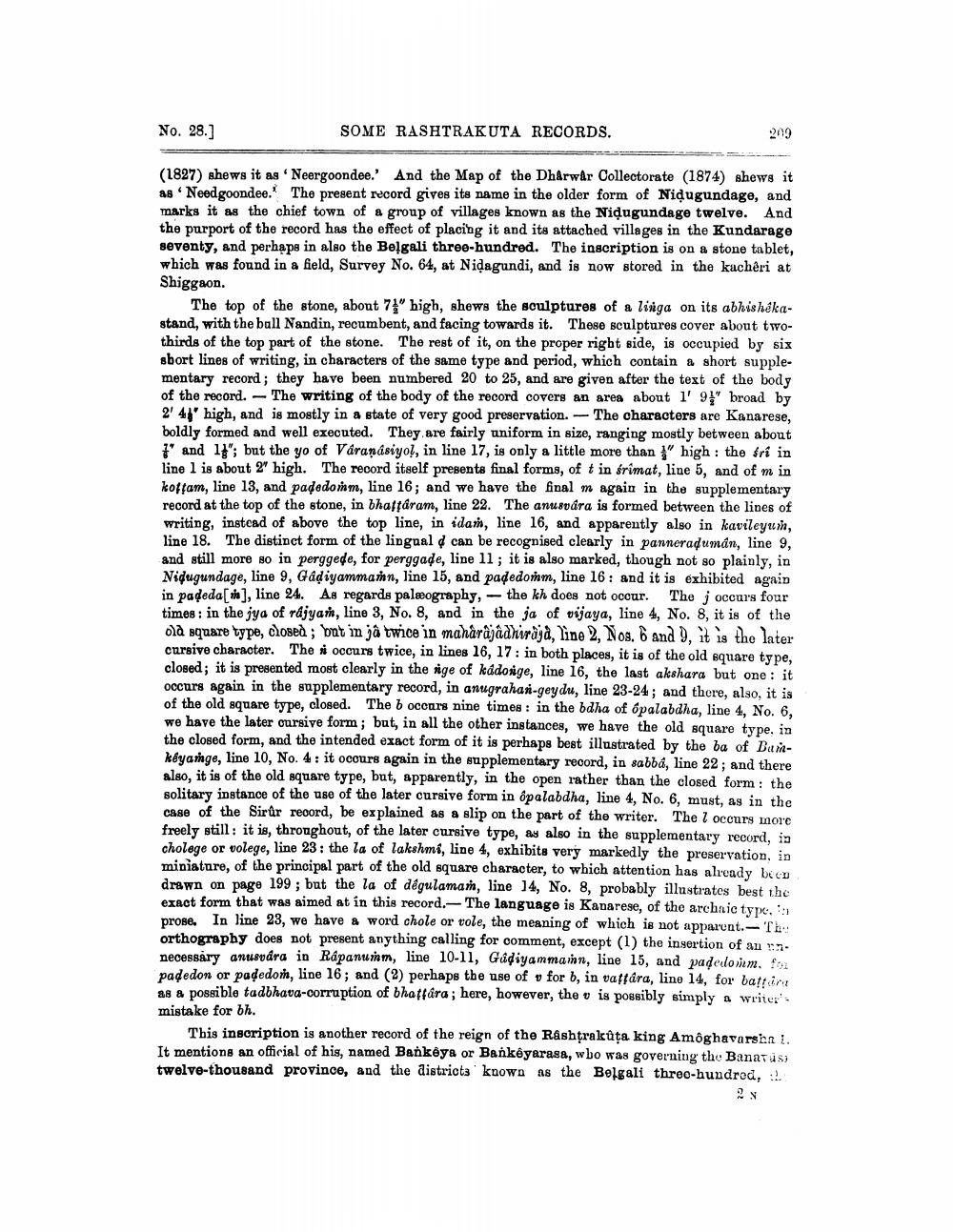________________
No. 28.]
SOME RASHTRAKUTA RECORDS.
249
(1827) shews it as Neergoondee.' And the Map of the Dharwar Collectorate (1874) shews it 38 Needgoondee. The present record gives its name in the older form of Nidugundage, and marks it as the chief town of a group of villages known as the Nidugundage twelve. And the purport of the record has the effect of placing it and its attached villages in the Kundarage seventy, and perhaps in also the Beļgali three-hundred. The inscription is on a stone tablet, which was found in a field, Survey No. 64, at Nidagundi, and is now stored in the kuchéri at Shiggaon.
The top of the stone, about 7 high, shews the sculptures of a linga on its abhishekastand, with the ball Nandin, recumbent, and facing towards it. These sculptures cover about twothirds of the top part of the stone. The rest of it, on the proper right side, is occupied by six sbort lines of writing, in characters of the same type and period, which contain a short supplementary record; they have been numbered 20 to 25, and are given after the text of the body of the record. - The writing of the body of the record covers an area about l' 9" broad by 2' 41 high, and is mostly in a state of very good preservation. The characters are Kanarese, boldly formed and well executed. They are fairly uniform in size, ranging mostly between about 7' and 1}"; but the yo of Varanasiyol, in line 17, is only a little more than " high : the fri in line 1 is about 2 high. The record itself presents final forms, of t in srimat, line 5, and of m in koftam, line 13, and padedomm, line 16; and we have the final m again in the supplementary record at the top of the stone, in bhaftáram, line 22. The anusvára is formed between the lines of writing, instead of above the top line, in idan, line 16, and apparently also in kavileyun, line 18. The distinct form of the lingual d can be recognised clearly in panneraduman, line 9, and still more so in perggede, for perggade, line 11; it is also marked, though not so plainly, in Nidugundage, line 9, Gadiyammann, line 15, and padedom, line 16: and it is exhibited again in padeda[m], line 24. As regards palæography, - the kh does not occur. The j occurs four times: in the jya of rajyar, line 3, No. 8, and in the ja of vijaya, line 4, No. 8, it is of the ola square type, closed; but in jâ twice in maharajadhiraja, line 2, No.6 and 9, it is the later cursive character. The si occurs twice, in lines 16, 17: in both places, it is of the old square type, closed; it is presented most clearly in the nige of kádonge, line 16, the last akshara but one: it occurs again in the supplementary record, in anugrahar-geydu, line 23-24 ; and there, also, it is of the old square type, closed. The b occurs nine times: in the bdha of ốpalabdha, line 4, No. 6, we have the later cursive form; but, in all the other instances, we have the old square type, in the closed form, and the intended exact form of it is perhaps best illustrated by the ba of Dankayange, line 10, No. 4: it ocours again in the supplementary record, in sabbá, line 22; and there also, it is of the old square type, but, apparently, in the open rather than the closed form : the solitary instance of the use of the later cursive form in opalabdha, line 4, No. 6, must, as in the case of the Sirur reoord, be explained as a slip on the part of the writer. The l occurs more freely still : it is, throughout, of the later cursive type, as also in the supplementary record, in cholege or volege, line 23: the la of lakshmi, line 4, exhibits very markedly the preservation, in miniature, of the principal part of the old square character, to which attention has already been drawn on page 199; but the la of dêgulaman, line 14, No. 8, probably illustrates best the exact form that was aimed at in this record.-The language is Kanarese, of the archaic type, prose. In line 23, we have a word chole or role, the meaning of which is not apparent. Th. orthography does not present anything calling for comment, except (1) the insertion of an a necessary anusvára in Rapanuim, line 10-11, Gadiyammann, line 15, and padelovim. for padedon or padedom, line 16; and (2) perhaps the use of v for b, in vaffara, line 14, for batting as a possible tadbhava-corruption of bhattara; here, however, the v is possibly simply a writer's mistake for bh.
This inscription is another record of the reign of the Rashtrakūta king Amôghavarsha I. It mentions an official of his, named Bankeys or Bankėyarasa, wbo was governing the Banatus) twelve-thousand province, and the districts known as the Belgali three-hundred, .




